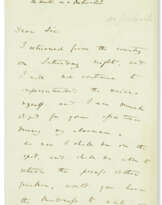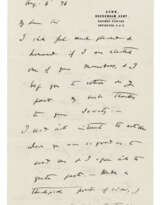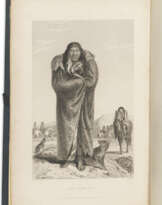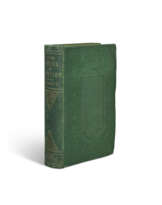ID 1032688
Lot 36 | The Descent of Man
Estimate value
$ 35 000 – 55 000
A highly important presentation copy of the first edition, first issue, given to Henry Walter Bates, Darwin’s colleague and collaborator on important sections of the Descent. The word "evolution" appears here for the first time in any of Darwin’s works, on page 2 of the first volume, "before its appearance in the sixth edition of the Origin of Species in the following year" (Freeman p.129). "In the Origin Darwin had avoided discussing the place occupied by Homo sapiens in the scheme of natural selection, stating only that 'light will be thrown on the origin of man and his history.' Twelve years later he made good his promise with The Descent of Man, in which he compared man’s physical and psychological characteristics to similar traits in apes and other animals, showing how even man’s mind and moral sense could have developed through evolutionary processes. In discussing man’s ancestry Darwin did not claim that man was directly descended from apes as we know them today, but stated simply that the extinct ancestors of Homo sapiens would have to be classified among the primates; however, this statement, as misinterpreted by the popular press, caused a furore second only to that raised by the Origin" (Norman).
There are several important differences between the first and second issues; the most serious is the subject of a one-page inserted "Postscript" at the beginning of Vol II where Darwin confesses he has fallen into "a serious and unfortunate error" on pages 297-9 in the first volume and pages 161 and 237 in the second volume concerning sexual selection. This leaf does not appear in the second issue, as the offending passage, and several others detailed in the extensive errata, were corrected in the later printing. 2500 copies of the first issue were published on February 24, and 2000 copies of the second issue in March. Henry Walter Bates (1825–1892) was a prominent Darwinian and contributed significantly to the Descent. His contributions are cited some 16 times in the index, and Darwin had proofs sent to him requesting his expertise with the entomological section (pp 341–423).
Bates had exchanged specimens with Alfred Russel Wallace in 1847 and in 1848 Bates and Wallace sailed for Brazil together. Wallace returned in two years, but Bates stayed until 1859. On his return to England he became an immediate and important supporter of Darwin's theories. "Bates arrived in England with two gifts for Darwin. One was the concept of insect mimicry. The other was a collection of butterflies that displayed evolutionary diversification ... Mimicry was an unusual feature of the living world that not even Darwin could have anticipated ... Bates explained to Darwin how this protective mimicry must emerge through adaptation and selection. By eating some insects and not others, birds were naturally selecting the forms and colourings that would survive. The better the mimic, the better the survival rate. He provided a full account in a paper delivered at the Linnean Society in London in 1862." (Janet Browne, Charles Darwin II, pp 224-225).
It was due to Darwin’s warm encouragement that Bates wrote The Naturalist on the River Amazons (published by Murray in 1863), considered a masterpiece of scientific travel literature. Darwin himself reviewed it in the Natural History Review upon its publication. In 1873, when Darwin wanted Wallace to revise The Descent of Man for a second edition, he made the enquiry through Bates. Freeman 937; Garrison and Morton 170; Norman 599
Two volumes, octavo (184 x 120mm). Illustrated with wood-engravings. 16 pp publisher's advertisements in both volumes; both dated January 1871 (few minor spots/smudges at ends). Original green cloth stamped in blind, spines gilt (a little unobtrusive strengthening to hinges). Provenance: Henry Walter Bates, 1825-1892 (presentation inscription "From the Author" in the hand of one of the publisher's clerks and another inscription "To H.W. Bates" on the front flyleaf, presumably added by another of Murray's clerks, as Murray was also Bates's publisher). Darwin’s list of intended presentation copy recipients, sent to Murray, and where Bates is named, is in the Darwin Correspondence, vol 19, p 796. The clerk who inscribed this presentation inscribed others as well, including at least one first edition Origin of Species.
| Artist: | Charles Robert Darwin (1809 - 1882) |
|---|---|
| Place of origin: | England |
| Auction house category: | Medicine & science, Printed books |
| Artist: | Charles Robert Darwin (1809 - 1882) |
|---|---|
| Place of origin: | England |
| Auction house category: | Medicine & science, Printed books |
| Address of auction |
CHRISTIE'S 20 Rockefeller Plaza 10020 New York USA | ||||||||||||||
|---|---|---|---|---|---|---|---|---|---|---|---|---|---|---|---|
| Preview |
| ||||||||||||||
| Phone | +1 212 636 2000 | ||||||||||||||
| Fax | +1 212 636 4930 | ||||||||||||||
| Conditions of purchase | Conditions of purchase | ||||||||||||||
| Shipping |
Postal service Courier service pickup by yourself | ||||||||||||||
| Payment methods |
Wire Transfer | ||||||||||||||
| Business hours | Business hours
|














